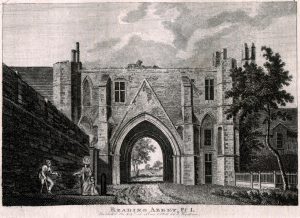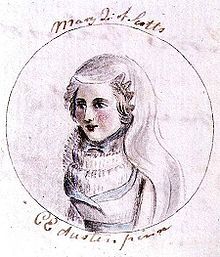
As this month’s theme has to do with Jane Austen and School, let us begin with a visit, in fact and in story, to the school Jane Austen herself attended. Other treatments of the theme might deal with her characters at school – or university – or threatened with working as governesses – or anything else that strikes our fancy!
The Abbey School at Reading was a boarding establishment for young ladies, well reputed and in a healthy situation, that was recommended to Rev. George Austen as the place to send his daughters. Their cousin Jane Cooper was also being sent by her father, Rev. Edward Cooper. The cousins had already suffered a tragedy in their schooling. Two years earlier, when Cassandra was ten, Jane Cooper a year older, and little Jane Austen only seven, the three girls had been sent to a school kept by an aunt of Jane Cooper’s, Mrs. Cawley, in Oxford. Owing to an epidemic of measles, the school was soon moved to Southampton, but there the children fell victim to a terrible outbreak of putrid fever, or typhus, and all were seriously ill. Mrs. Cawley would not write to their mothers, but Jane Cooper did, and Mrs. Austen and her sister Mrs. Cooper hurried to Southampton to nurse the children and take them home. They survived, but Mrs. Cooper caught the disease and died. Jane Cooper thereafter spent most of her time with the Austen family, until it was decided to try the school experiment again. Girls were not considered to need a classical education such as boys received, but there was a practical consideration: With the girls away from Steventon, the Austens could take in additional boy pupils and bring in more than enough money to pay for the Abbey School fees.

There had been no need for Jane to go to the Oxford school at only seven, but she was so distressed at the idea of being parted from her big sister that her parents permitted it. Mrs. Austen later wrote: “If Cassandra were going to have her head cut off, Jane would insist on sharing her fate.” Jane nearly died in her illness, and was delicate for a year after the Southampton tragedy, but now at nine she was strong and healthy again, and of a more suitable age to go to school. Besides, she was quite excited at the description of the place. The Abbey School was situated in the medieval gatehouse of a ruined twelfth century Benedictine Abbey; a most romantic spot, with beautiful old-fashioned gardens called The Forbury where the girls might play. As can be supposed, Jane was wild to see the Abbey; and on arrival her imagination must have received delicious frissons of fright by the other girls filling the newcomers’ ears with lurid stories of the objects found in the ruins. That very year there had been discovered a shriveled hand, and a full skeleton was dug out of a wall. It must have been agreeably cozy in the turret bedrooms, each containing three beds for six girls, with Jane and Cassandra sharing theirs. This may be where Jane got her indoctrination and her taste for “horrid stories.”

Educationally, the institution was rather lax. It was run by a Madame Latournelle, who was neither married nor French; her real name was Sarah Hackitt, and she was a stout elderly person dressed in an unchanging old-time style with neatly pinned muslin apron and cap, and ruffled short sleeves. She possessed an artificial leg made of cork, and even the girls’ most fanciful conjectures never succeeded in divining the circumstances in which she had lost a leg. She was good natured and easy going, and did not teach the girls herself, contenting herself with making tea and giving out clean linens; there were mistresses for French, dancing and needlework. After only an hour or two of lessons in the mornings, the girls were generally let alone to do as they liked. Mrs. Latournelle was always very ready, however, to tell them stories about her visits to the theatre, and backstage gossip about the actors; for she loved a play, and even allowed the girls to put on their own dramatic turns at the end of each term. It was altogether an agreeable school and the girls were happy there, though they might be supposed to be like the scholars in Mrs. Goddard’s school in Emma, who “might scramble themselves into a little education without any danger of coming back prodigies.”
One wet November afternoon it was too rainy to go into the gardens, and the mistresses were all occupied in taking naps. Cassandra, Jane, and their cousin retreated into the turret room that they shared with three sisters, and sat on the beds, staring disconsolately at the water pouring down the uneven medieval glass. The other girls, Mary, Martha and Matilda Harding, who came from Bath, and were also clergymen’s daughters, about the same ages as the first three, greeted them clamorously.
“Isn’t it awful! There’s not a chance of it stopping,” complained Mary. “We can’t go out, and there’s nothing to do.”
“We can have a revel, can’t we?” suggested Jane Cooper. “We’ve got some nuts, and apples.”
“We have a plum cake sent from home that we can share,” said Martha.
“And Jane will tell us stories!” finished Matilda.
“Yes! Hers are the best. You will, Jane, won’t you? Tell us about the ghost of Henry II that walks about on dark nights and has no eyes!”
“Or the spectres of King John’s daughters that walk through walls!”
“Why, we know all those stories,” objected Jane Cooper, “everyone does. You told them to us yourselves on our first day here.”
“And we should not make so much of Jane,” said Cassandra, “too much attention will go to her head.”
“It won’t,” said Jane. “I could tell the one about the lovely nymph who had her head cut off in our very garden, or the nun who was walled up for thirty-seven years, very near to where we are sitting…”
“Yes, yes,” chorused the sisters, “and we will cut up the cake.”
They were raptly absorbed in Jane’s most lurid tales, when a thumping was heard coming along the passage.
“It’s La Latournelle and her peg,” said Jane Cooper.
“Never fear; she doesn’t mind our telling stories.”
“No. I wonder what she wants.”
The stout lady stumped into the room and stood looking at the girls, hands on hips. “Well! So this is how you occupy yourselves when you should be improving your minds,” she said, but without the least rancor.
“Oh, Ma’am, what else could we do on such a rainy day,“ protested Mary. “We’ve read all our books, and have had our lessons for the morning.”
“Ah, very true. And you have been eating cake, I can see the crumbs.”
“We are sorry it is all eaten, or we would offer you a piece,” said Cassandra politely.
“There are still nuts, won’t you have some?” offered Mary.
“Thank you, young ladies. I don’t mind if I do,” said their teacher, crunching an almond. “But what I came to talk to you about is, I thought you might like to get up a play to amuse yourselves.”
“Oh, could we!” cried Jane, who was usually shy except when telling stories.
“Indeed yes. And I thought you, our writing girl, might write it!”
The girls all loudly voiced approval, and Cassandra said, “Why, she was just telling us a story about Mary Queen of Scots being murdered by the evil Queen Elizabeth, that would do very well!”

Portrait of Mary Queen of Scots, drawn by Cassandra Austen, supposedly with Jane Austen’s face!
“That sounds just right,” agreed Mrs. Latournelle. “Historical, educational and you can throw in a few ghosts. Well, I will leave you girls to it. Turn out a play, Miss Jane, and you girls will act in it tomorrow!”
Smiling around the room, and crunching cheerfully on nuts, she clumped out. “Can’t I be Mary Stuart?” begged one of the sisters.
“No, I want that part!” demanded another.
“We all do, but only one of us can play Mary,” said Jane Cooper. “Cassandra looks most like her, and should take the part. Cousin Jane, will you like to be Elizabeth?”
“No, not I; you are tall and will do justice to Elizabeth yourself.”
“But what about us? Who can we play?” asked the sisters in concern.
“You will say the Prologue, Mary, and Martha the Epilogue; and Matilda will be the executioner.”
“And you, Jane? Who will you be?”
“Oh, I will be the author. Give me those bits of paper on the desk, and I’ll start writing out all your lines. That will be good enough for me,” replied Jane, her eyes sparkling.

Portrait of Queen Elizabeth I, drawn by Cassandra Austen, supposedly based on Mrs. Austen’s features.

8 comments
Skip to comment form
Thank you for this informative, entertaining and charmingly written piece.
Author
Thank you for making me feel it worthwhile, JoEllen!
Quite Charming.
Author
Thanks Nancy! 🙂
Informative and delightful! I love how you brought in the Juvenalia in your tale.
Author
Thanks, Abigail, so glad you liked this! And while we are mutually complimenting (not being like Mrs. Elton, who said “I never compliment”) I want to tell you that your enchantment novel is one of the most enticing and charming new novel ideas I have seen in a long time – I think it’s going to be a classic!
How fun!!! I really enjoyed this!! I last read the Juvenilia nearly thirty years ago in grad school. 😉
Thank you for this amusing romp, Diana, as well as for the informative peek into the education provided to young ladies at this time.
Warmly,
Susanne 🙂
Author
Thank you, Susanne! I always love it when you read something I’ve written, you are so kind with your comments! 🙂